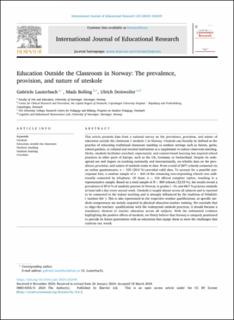| dc.contributor.author | Lauterbach, Gabriele | |
| dc.contributor.author | Bølling, Mads | |
| dc.contributor.author | Dettweiler, Ulrich | |
| dc.date.accessioned | 2024-04-10T11:52:53Z | |
| dc.date.available | 2024-04-10T11:52:53Z | |
| dc.date.created | 2024-03-30T16:29:53Z | |
| dc.date.issued | 2024 | |
| dc.identifier.citation | Lauterbach, G., Bølling, M. & Dettweiler, U. (2024) Education Outside the Classroom in Norway: The prevalence, provision, and nature of uteskole. International Journal of Educational Research, 125, 102349 | en_US |
| dc.identifier.issn | 0883-0355 | |
| dc.identifier.uri | https://hdl.handle.net/11250/3125806 | |
| dc.description.abstract | This article presents data from a national survey on the prevalence, provision, and nature of education outside the classroom (“uteskole”) in Norway. Uteskole can broadly be defined as the practice of relocating traditional classroom teaching to outdoor settings such as forests, parks, school gardens, or cultural and societal institutions as a supplement to indoor classroom teaching. Herby, uteskole facilitates enriched, experiential, and context-based learning has inspired school practices in other parts of Europe, such as the UK, Germany or Switzerland. Despite its widespread use and impact on teaching nationally and internationally, no reliable data on the prevalence, provision, and nature of uteskole exists to date. From a total of 2671 schools contacted via an online questionnaire, n = 535 (20.0 %) provided valid data. To account for a possible non-response bias, a random sample of n = 460 of the remaining non-responding schools was additionally contacted by telephone. Of those, n = 334 offered complete replies, resulting in a representative sample. Based on a total sample of N = 869 schools (32.53 %), the results reveal a prevalence of 87.6 % of uteskole practice in Norway in grades 1–10, and 68.7 % practice uteskole at least half a day every second week. Uteskole is taught almost across all subjects and is reported to be connected to the indoor teaching and is strongly influenced by the tradition of friluftsliv (“outdoor-life”). This is also represented in the respective teacher qualifications, as specific uteskole competences are mainly acquired in physical education teacher training. We conclude that to align the teachers’ qualifications with the widespread uteskole practices, it should become a mandatory element in teacher education across all subjects. With the substantial evidence highlighting the positive effects of uteskole, we firmly believe that Norway is uniquely positioned to provide its future generations with an education that equips them to meet the challenges that confront our world. | en_US |
| dc.language.iso | eng | en_US |
| dc.publisher | Elsevier Ltd. | en_US |
| dc.rights | Navngivelse 4.0 Internasjonal | * |
| dc.rights.uri | http://creativecommons.org/licenses/by/4.0/deed.no | * |
| dc.subject | utdanningsvitenskap | en_US |
| dc.subject | uteskole | en_US |
| dc.title | Education Outside the Classroom in Norway: The prevalence, provision, and nature of uteskole | en_US |
| dc.type | Peer reviewed | en_US |
| dc.type | Journal article | en_US |
| dc.description.version | publishedVersion | en_US |
| dc.rights.holder | © 2024 The Author(s). | en_US |
| dc.subject.nsi | VDP::Samfunnsvitenskap: 200::Pedagogiske fag: 280 | en_US |
| dc.source.volume | 125 | en_US |
| dc.source.journal | International Journal of Educational Research | en_US |
| dc.identifier.doi | 10.1016/j.ijer.2024.102349 | |
| dc.identifier.cristin | 2257686 | |
| dc.source.articlenumber | 102349 | en_US |
| cristin.ispublished | true | |
| cristin.fulltext | original | |
| cristin.qualitycode | 2 | |

